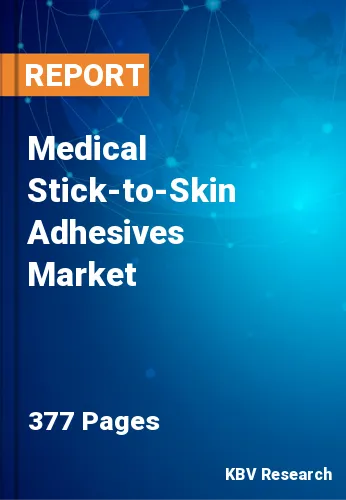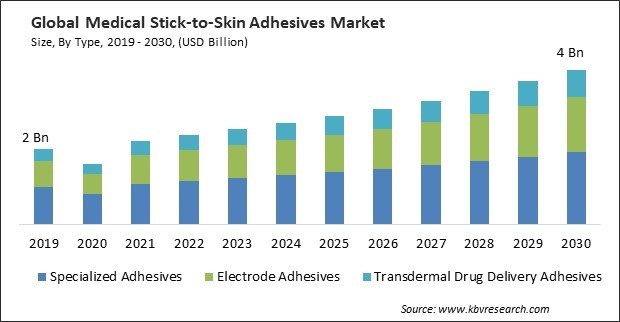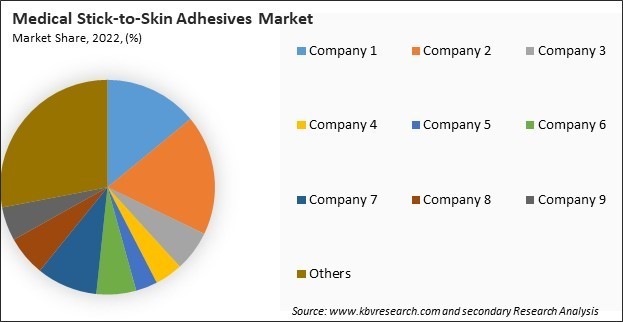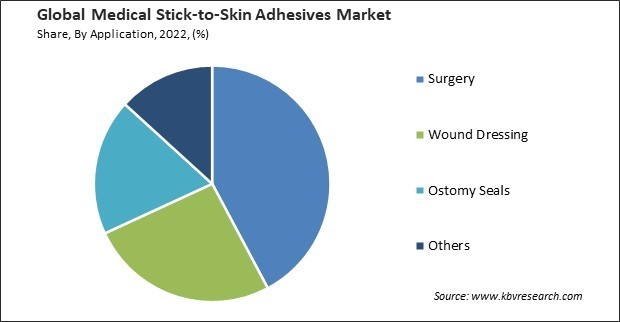
The Global Medical Stick-to-Skin Adhesives Market size is expected to reach $4.0 billion by 2030, rising at a market growth of 7.2% CAGR during the forecast period.
Rubber-based adhesives can provide a certain level of shock absorption, which may be advantageous in applications where the medical device is subjected to movement or impact. Therefore, the rubber-based segment captured $398.5 million revenue in the market in 2022. Rubber-based adhesives can resist moisture, which is crucial in applications where the adhesive may meet sweat, water, or other bodily fluids. This resistance helps maintain the adhesion of medical devices in various environmental conditions. Rubber-based adhesives often exhibit good temperature stability, maintaining their properties over various temperatures. This is important for medical devices exposed to varying environmental conditions during storage, transportation, or use. Some of the factors impacting the market are rising incidence of chronic diseases, increasing awareness of preventive healthcare, and significant regulatory compliance issues.

Diabetes is a prevalent chronic disease, and individuals with diabetes often require continuous monitoring of their blood glucose levels. Medical stick-to-skin adhesives are essential components in applying continuous glucose monitoring devices. These adhesives securely adhere sensors to the skin, enabling continuous and real-time glucose monitoring without fingerstick tests. Chronic conditions such as cardiovascular diseases (CVD) often require continuous monitoring of vital signs. Wearable health technology, including adhesive-based devices like heart rate monitors and ECG sensors, is becoming increasingly popular. Additionally, the emphasis on preventive healthcare measures has increased health monitoring and management awareness. These facilitate continuous monitoring, supporting early detection and preventive healthcare practices. Preventive healthcare emphasizes monitoring health parameters continuously to detect deviations from normal at an early stage. These enable the secure attachment of sensors and monitoring devices to continuously track vital signs, facilitating early detection of health issues. As a result of the increasing awareness of preventive healthcare, the market is anticipated to increase significantly.
The medical industry, including producing medical adhesives, faced challenges related to supply chain disruptions during the pandemic. Transportation restrictions, factory closures, and fluctuations in raw material availability impacted the manufacturing and distribution of these adhesives. The demand for several medical adhesives used in surgical applications was impacted by the pandemic's ability to cause the postponement or cancellation of elective medical procedures. The pandemic's issues encouraged technological developments in the healthcare sector, including creating more advanced and user-friendly stick-to-skin adhesives. The need for remote monitoring solutions and wearable devices prompted quicker advancements in these adhesives' design, functionality, and connectivity. Stick-to-skin adhesives play a crucial role in attaching monitoring devices for remote patient monitoring, contributing to the increased demand for wearable medical devices and associated adhesives. Thus, the COVID-19 pandemic had a moderate effect on the market.
However, the approval process for medical stick-to-skin adhesives can be time-consuming and complex. Regulatory agencies require manufacturers to provide extensive documentation, including preclinical and clinical data, to demonstrate the safety and efficacy of the products. This lengthy approval process can delay the introduction of new products to the market. Complying with regulatory standards often requires significant financial investments in research, testing, and documentation. Regulatory compliance includes mandatory reporting of adverse events associated with the use of medical devices, including stick-to-skin adhesives. Manufacturers must establish robust post-market surveillance systems to monitor and report adverse events promptly. This reporting obligation can impact a product's reputation and market acceptance. Regulatory compliance is a significant challenge that hampers the growth of market.

The leading players in the market are competing with diverse innovative offerings to remain competitive in the market. The above illustration shows the percentage of revenue shared by some of the leading companies in the market. The leading players of the market are adopting various strategies in order to cater demand coming from the different industries. The key developmental strategies in the market are Acquisitions, and Partnerships & Collaborations.
On the basis of type, the market is divided into electrode adhesives, transdermal drug delivery adhesives, and specialized adhesives. In 2022, the specialized adhesives segment dominated the market with maximum revenue share. Specialized adhesives are often formulated with materials that are gentle on the skin. They minimize the risk of skin irritation, allergies, or damage, making them suitable for prolonged contact with the skin. This ensures a secure and comfortable fit, even in areas with frequent movement. These properties are crucial for medical applications where the adhesive needs to adhere effectively to joints and other flexible body parts.
Based on backing material, the market is classified into paper, fabric, plastic, and others. The fabric segment acquired a substantial revenue share in the market in 2022. Fabric-based adhesives are generally gentle on the skin, reducing the risk of irritation. This makes them suitable for people with sensitive skin or prone to allergic reactions. The reduced risk of skin irritation contributes to patient comfort and overall satisfaction. Fabrics can provide durability and resilience in adhesive applications. This is important for scenarios where the adhesive needs to withstand movement, stretching, or other physical stresses.
By application, the market is segmented into surgery, wound dressing, ostomy seals and others. In 2022, the surgery segment registered the maximum revenue share in the market. Adhesives are used to fix medical devices and drapes during surgery temporarily. This includes securing catheters, tubes, and monitoring devices, ensuring stability, and preventing unintended movement that can disrupt the surgical process. In laparoscopic surgery, trocar sites require closure after the insertion and removal of instruments. Adhesive closures provide a convenient and effective means of closing these small incisions, contributing to the overall success of laparoscopic procedures.

Based on end-user, the market is fragmented into hospitals & clinics, home care settings, and others. The home care settings segment covered a considerable revenue share in the market in 2022. The use of monitoring devices in home care is rising, and these adhesives are crucial in securing these devices. Whether it's adhesive electrodes for ECG monitoring or patches for continuous glucose monitoring, adhesives ensure the stability and accuracy of data collection in telehealth applications. Adhesive products are utilized in home-based rehabilitation programs, including securing devices used in physical therapy and monitoring equipment for rehabilitation progress.
By product, the market is categorized into acrylic-based, silicone-based, rubber-based, hydrogel-based, and others. In 2022, the acrylic-based segment held the highest revenue share in the market. Acrylic-based adhesives are employed to manufacture adhesive components for wearable medical devices. These devices, including fitness trackers, continuous glucose monitors, and smartwatches, often require a reliable and long-lasting adhesive to stay attached to the skin. Acrylic adhesives provide the necessary adhesion while offering comfort and flexibility. The biocompatibility of acrylic-based adhesives makes them suitable for pediatric and geriatric care.
| Report Attribute | Details |
|---|---|
| Market size value in 2022 | USD 2.3 Billion |
| Market size forecast in 2030 | USD 4 Billion |
| Base Year | 2022 |
| Historical Period | 2019 to 2021 |
| Forecast Period | 2023 to 2030 |
| Revenue Growth Rate | CAGR of 7.2% from 2023 to 2030 |
| Number of Pages | 377 |
| Number of Table | 570 |
| Report coverage | Market Trends, Revenue Estimation and Forecast, Segmentation Analysis, Regional and Country Breakdown, Market Share Analysis, Porter’s 5 Forces Analysis, Company Profiling, Companies Strategic Developments, SWOT Analysis, Winning Imperatives |
| Segments covered | Type, Product, Backing Material, Application, End-User, Region |
| Country scope |
|
| Companies Included | 3M Company, Johnson & Johnson, Avery Dennison Corporation, Smith & Nephew PLC, Nitto Denko Corporation, DuPont de Nemours, Inc., Medtronic PLC, B. Braun Melsungen AG, Henkel AG & Company, KGaA, and Lohmann & Rauscher GmbH & Co. KG |
| Growth Drivers |
|
| Restraints |
|
Region-wise, the market is analyzed across North America, Europe, Asia Pacific, and LAMEA. In 2022, the North America region led the market by generating the highest revenue share. North America boasts a highly advanced healthcare infrastructure, including state-of-the-art hospitals, clinics, and research facilities. In North America, the demand for medical stick-to-skin adhesives is driven by the high prevalence of chronic diseases such as diabetes, cardiovascular problems, and respiratory disorders. The aging population in North America has resulted in a greater emphasis on healthcare solutions that address the needs of older persons.
Free Valuable Insights: Global Medical Stick-to-Skin Adhesives Market size to reach USD 4 Billion by 2030
The market research report covers the analysis of key stake holders of the market. Key companies profiled in the report include 3M Company, Johnson & Johnson, Avery Dennison Corporation, Smith & Nephew PLC, Nitto Denko Corporation, DuPont de Nemours, Inc., Medtronic PLC, B. Braun Melsungen AG, Henkel AG & Company, KGaA, and Lohmann & Rauscher GmbH & Co. KG
By Type
By Backing Material
By Application
By End-User
By Product
By Geography
The Market size is projected to reach USD $4.0 billion by 2030.
Increasing awareness of preventive healthcare are driving the Market in coming years, however, Significant regulatory compliance issues restraints the growth of the Market.
3M Company, Johnson & Johnson, Avery Dennison Corporation, Smith & Nephew PLC, Nitto Denko Corporation, DuPont de Nemours, Inc., Medtronic PLC, B. Braun Melsungen AG, Henkel AG & Company, KGaA, and Lohmann & Rauscher GmbH & Co. KG
The expected CAGR of this Market is 7.2% from 2023 to 2030.
The Paper segment is registering the maximum revenue in the Market by Backing Material in 2022; thereby, achieving a market value of $1.7 billion by 2030.
The North America region dominated the Market by Region in 2022 and would continue to be a dominant market till 2030; thereby, achieving a market value of $1.5 billion by 2030.
Our team of dedicated experts can provide you with attractive expansion opportunities for your business.
